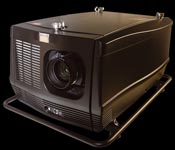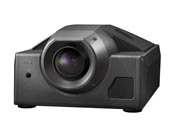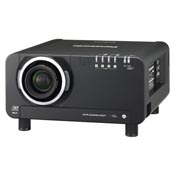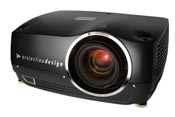The Arms Race Heats Up

- I recently completed a market research and analysis project on large venue projectors for a client and was reviewing the material that I had collected for the report. For this project we had taken all of the projectors from 3K lumens and above and compared each and every one of them in terms of specifications, price, features, and real benefits. For some of you this may seem like tedious work but in fact it was extremely interesting at least to your erstwhile writer. As some of you will recall, I have spent the last few years immersed in the flat panel world constrained to images less than 103 feet so this project liberated me to the full images only unfettered large screen projectors can provide. It is good to be home!
- In the section of the report concentrating on projectors producing 10K lumens and above, I was taken back in time to the Hughes-JVC ILA-12K projector of the mid to late 1990s. It gave us"whopping" 12K lumens (on a good day) and weighed approximately 500 pounds. It cost $300k and was far from portable or easy to maintain but in all fairness produced one of the best pictures I have ever seen even in today's 2K resolution terms. Back in the real world, I began to think about the features of the early large venue projectors and the cost to the rental and staging companies that has purchased them and the return on investment that they had or, in some cases, had not achieved. The early adopters were brave indeed and the industry was fraught with horror stories on failures in the field at the worst possible times. We say this as if there is anything but the worst possible time to have a failure in the rental and staging industry.
- Let's take a look at where we are in the world of large venue projection, examine who the "players" are, what common features tie this niche together, and finally, does it makes sense to invest in current products for the next five years of the business.
- In the early days of large venue, we had several technologies from which to choose. We had the GE Talaria and Eidaphor with their oil filled light valves. Along came Hughes Aircraft and their light valve that was CRT driven and in later iterations called the ILA. This was closely followed by high brightness LCD and DLP digital projectors which soon eclipsed all the light valve producers. Hughes had joined with JVC and this joint venture brought out the D-ILA a proprietary form of LCoS technology as their response to the other digital projection technologies and most recently we see Sony with their SXRD versions of LCoS. So today, who is on top from a technology and manufacturing point of view?
- In my opinion, in large venue applications, DLP is the winner with all due respect to the LCoS camp. We can debate the quality of images between the newest 2K DLP cinema chip and the 2K and incredible 4K Sony SXRD chip but in the rental and staging markets, DLP dominates, except for the 12K LCD products out there based on Sanyo technology. If we examine the projector manufacturers in large venue/high lumen category, Digital Projection, Christie Digital, and Barco are the major players in this niche and all use 3 chip DLP designs for their rental and staging projectors over 12K lumens.
- We would be remiss if we did not mention the resolution "wars." In the DLP camp we have the 1400x1050 and the 1920x1080 chips but the king of the hill is their 2048x1080 commonly referred to as their 2K digital cinema chip. The current debate is whether it is worth the extra investment to go to the models coming out with the 2K digital cinema chip over the 1920x1080 variety. The answer is based on application. If your end users are involved in digital cinema or the showing of Digital Cinema Initiative (DCI) compatible material, then the benefits of the 2K chip and its attendant color space and black level capabilities are reasons for the extra investment. What further complicates the resolution "wars," at least in digital cinema, is the new 4K LCoS chips from Sony. They are doing their best to convince the film world that 4K, not 2K, is the holy grail of replicating film on screen. This writer knows how long it took to come to an agreement on the 2K standard and the adoption of 4K as the "true" standard by which digital cinema is evaluated is several years away. The bottom line here is that in the upper end of your investment, the resolution issue needs to be considered and the 1920x1080 resolution is a smart bet moving forward.
- As we know, there have been huge advances in the quality of display products at all levels from small conference room displays to large venue projectors. Our research compared all the large venue projectors on the market and found that they had all progressed even farther in terms of performance, features and benefits than their brethren of a more miniscule variety. This bodes well if you are considering your next wave of investing in the high end. There were some common threads that nearly all the manufacturers embraced. For example, each of the big contenders included sealed optics to protect the vitally important optical engines in their digital projectors. This feature alone has saved untold hours in projector maintenance and extended the life of the projector. As we know, the power supply to ignite and regulate the high brightness Xenon lamps has been historically a weak point and the manufacturers have listened. All of them now offer much improved power supplies and some have multiple power supplies or offer them as options.
- The Xenon lamps themselves have been improved to offer an even better and more consistent color temperature and longer life in the process. DPI, Christie, and Barco have also gone out of their way to develop projector chassis with rigging and stacking capabilities that will stand up to the abuse of the road warrior. They each make lamp replacement much easier and input cards accessible. In a couple of cases, they even offer LCD control screens on the projectors for those rare times (humor) where the remote control is lost. Add to these improvements edge blending, power lens shift, easy change optics, remote diagnostics and you have compelling products that will last long after the final payment is made.
- Perhaps the most significant improvements have been made in the quality of the images we see on screen produced by recent large venue products. We have discussed resolution of the chips and that certainly adds to the quality of the images we see but there are other improvements that have significant positive effects that go beyond resolution. The first area of improvement is contrast and more correctly black level uniformity and dynamic range. The current crop of large venue projectors is giving us 1500 to 2000:1 contrast and the calibration capability to provide uniformity over 90 percent of the screen. The second area of improvement is in the scaling engines and image processors that the big boys use. Each one has their own proprietary version but the improvements in picture quality are outstanding. Last but not least on the hit parade of improvements is the migration to 10 bit and 12 bit processing. These improvements are not found under the heading of being subtle.
- Now we come to the cost of entry into this exclusive club. Prices for 12K lumen projectors can be as "low" as $30K and as high as $80K depending on features and resolution. When we go to 20K lumen projectors, prices range from $90K to $119K and the big guns at 25/30K lumens can reach the $130K to $160K plateau. These investments are not for the faint of heart but are a significant part of the cost of doing business in rental and staging. There are a few questions that still need to be answered.
- The most obvious question involves when to make the plunge into the new versions of large venue projection. The answer to this question will differ for each one of you reading this column. With what we do know about the requirements for large venue projectors for the foreseeable future, the current crop meets the highest demand of resolution, brightness, contrast, and dynamic range. If you just purchased a whole fleet of large venue projectors three or even four years ago, it is a difficult move to consider. On the other hand, with what we know about the improvements that have been made in the latest products from DPI, Christie, Barco, and a few others like Panasonic and Sanyo, there is no better time to sell off the outdated inventory and make the new investment splash while your current stock has value in the market place. One fear that affects all of us about to make a huge investment involves whether there is a huge improvement just around the corner or a significant price drop. In our research, neither occurrence is likely to take place.
- Perhaps the most difficult question to address is whether you should buy new large venue projectors or depend on those that sub rent to supply your needs. Before going any further, let it be known that there will always be a good business in sub renting large venue projectors to a willing rental and staging industry. According to a recent market survey, there are 11,000 (yes 11K!) small, medium, and large companies in North America that fall under the definition of an AV rental company. Sub renting is a blessing for those who do a few events a year or even for the bigger regional companies that land a gig that tie up their own entire inventory.
- This being said, for those that are serious contenders in the large venue rental and staging market, the best ROI is to purchase or lease your own inventory and sub rent as needed and act as a sub rental house yourself to maximize inventory turns. The three major reasons for purchasing your own inventory are quality control and maintenance of the projectors, the ability to manage the flow and availability of the inventory, and the ability to price according to market demands and your client base.
- Only the individual rental and staging company can tell if the time is right for them to make a new investment in large venue projection. What we can say is that the market is migrating to HD signals, 16:9 aspect ratios, and both 720P an especially 1080P are buzz words we hear every day. We also know that the large venue manufacturers have developed truly reliable products that produce outstanding images on screen. The question ultimately is the ability of the rental and staging companies to market and sell the new large venue projector performance that is currently available. My advice? Call the manufacturers and have a little chat and perhaps a shoot out or two and see for yourself if now is the time to buy or not to buy. This is the question.
New Large Venue Projectors
NEC's NP4000
Designed primarily for corporate, government, and higher education facilities that require a powerfully projected image, NEC's 5000 ANSI lumen, XGA-native NP4000 features a full line of optional lenses with power horizontal and vertical lens shift for flexible placement anywhere. The NP4000's single or dual lamp operation allows users the flexibility to choose a light output that is right for the application. The NP4000 incorporates advanced video processing with BrilliantColor and DynamicBlack from Texas Instruments to deliver picture management control. Additionally, the NP4000 features user-changeable color wheels with four segments for full brightness or optional six segments for superior color fidelity. For more information visit www.nec.com.

Barco's FLM HD18
Barco's FLM HD18 is a quiet 18,000 lumens native HD projector, that is designed for applications in large events and venues. It also solves the increased need to project high brightness native HD images. The FLM boasts fully sealed optics and lamp maintenance ensuring an overall lower cost of ownership. Moreover, the lens range (TLD HB) of the Barco RLM and SLM projector series can be re-used on the FLM series, meaning users do not have to invest in new lenses. For more information visit www.barco.com.

Sony's SRX-S105 And SRX-S110
Sony's SRX-S105 (5,000 lumens) and SRX-S110 (10,000 lumens) each are equipped with three silicon X-tal reflective display (SXRD) imaging devices, delivering a resolution of 4096 x 2160 pixels (H x V)--more than four times the resolution of full HDTV (1920 x 1080). Both the SRX-S110 and the SRX-S105 offer a high contrast ratio of >1800:1 for precision imagery. Each projector is equipped with a DVI signal input module as standard, which provides the 1080/60P input capability available only with these units. In addition to the standard DVI input, three slots are available for the installation of other input modules. For more information visit www.sony.com

Christie's Roadie 25K
The Christie Roadie 25K is a revolutionary split-body projector utilizing 3-chip DLP technology. Its unique separate projection head and lamp ballast means both parts can be flown and rigged with greater ease, creating the ideal solution for challenging rental/staging installations and tight spaces.
With 2048 x 1080 resolution, 25,000 ANSI lumens and 10-bit image processing all standard, images are stunning in their size, brilliance and quality. This tough, user-friendly projector is built for frequent transport and quick set-up - perfect for any large audience venue demanding effortless installation and operation. For more information visit www.christiedigital.com

Panasonic's PT-DW10000U
Panasonic's new DLP system projector with 10,000 lumens of brightness is the PT-DW10000U, a full high-definition projector that can faithfully display HD content. High brightness is assured by a four-lamp system that delivers 10,000 lumens, while dynamic iris technology achieves a 5,000:1 contrast ratio. Three-chip DLP technology provides excellent resistance to deterioration due to aging, making the PT-DW10000U a reliable system projector. For more information visit www.panasonic.
A daily selection of the top stories for AV integrators, resellers and consultants. Sign up below.
Digital Projection's HIGHlite 10000Dsx+
The 9,500 ANSI Lumens, 2000 : 1 Contrast, 1400 x 1050 pixels HIGHlite 10000Dsx+ is a high powered large venue projector. The SXGA+ native resolution HIGHlite 10000Dsx+ Professional series projector provides an excellent combination of lumen output and ultra-rich contrast. The HIGHlite's combination of spectacular 3-chip DLP imaging accuracy, mechanical adaptability and supreme efficiency of operation sets the HIGHlite 10000Dsx+ apart from any other medium-to-large venue display. For more information visit www.digitalprojection.com.
Eiki's LC-XT4U
The LC-XT4U is Eiki's brightest projector yet. 12,000 ANSI lumens deliver a contrast of 1300:1. The optical imaging engine is optimized for extended use. The LC-XT4U uses native XGA and is compatible with UXGA through VGA, capable of video scaling. It can project images up to 40 feet wide (600 inches diagonal). It contains a quick-change lens installation system. A wide choice of lens is also available. It is compatible with most video signal inputs, including DVI, RGB, Y/C, DVD, and HDTV. It displays video 4:3 and 16:9 in NTSC/PAL/SECAM/NTSC 4.43/PAL-M/PAL-N. Th DVI input supports HDCP for true digital imaging. For more information visit www.eiki.com.

Projectiondesign's F30 Projector
A new professional projector from projectiondesign, the powerful F30 sx, displays pictures from single-chip DLP with DarkChip3 technology. This projector features Texas Instruments BrilliantColor technology that enhances images by reproducing a wider color spectrum and dramatically increases color saturation and visible gamut. The professional F30 sx+ series also features the unique projectiondesign RealColor technology, to deliver outstanding calibration and perfect color reproduction. The F30 has been designed to perform in a variety of environments and specialized applications such as simulators, 2D and 3D visualization and entertainment venues, as well as medical imaging, post-production, control rooms and display signage. For more information visit www.projectiondesign.com
